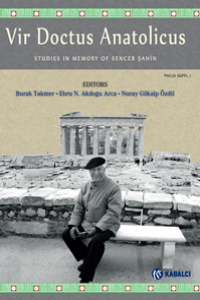Öz
Bu makalede Dağlık Kilikia’nın (Olba
territorimu) Korykos sınırları içerisinde kalan Hasanaliler Köyü’nde
(Gelinkayası) yürütülen yüzey araştırmaları sırasında bulunmuş olan bir stel
yerel karakteristik özellikleri açısından ve etkilenmiş olduğu dış etkenler
tanıtılmaktadır. Stel üzerinde bir çift cepheden resmedilmiştir. Stelin üst
kısmında bir yazıt, yazıtın üzerinde ise hilal motifi bulunmaktadır. Yazıtta da
Selene, epitheton’u Katakhtonia ile anılmaktadır. Hem kadın, hem de erkek
kabartması, kökeni Hellenistik Dönem Smyrna örneklerine geri giden ve Smyrna
tipi olarak da adlandırılan tiplerin bir anlamda varyasyonlarıdırlar. Ancak buradakiler
bilinen tiplerin ve ikonografilerin bir kısaltmasıdırlar. Bu nedenle söz konusu
kabartmayı işleyen usta veya sanatçının kökeni Hellenistik Dönem’e geri giden
ve Roma Dönemi eserleri üzerinden aktarımı olan bu ikonografik anlatımı
tanıdığını ve bildiğini ancak sipariş edilen bu mezar taşında bunları
kullanmaksızın siparişi tamamladığı anlaşılmaktadır. Yerel bir sanatçı veya
usta bu eseri çalışmış olmalıdır. Stilistik olarak chimation kıvrımları ve
saçların detayları Hellenistik Dönemin akıcılığını yansıtmamaktadır. Buna
karşın Roma Dönemi’nin koyu ve ağır hatlarını aksettirmektedir. Harf
karakterleri de yazıtın MS. 2. yüzyıla tarihlendirilmesine olanak vermektedir.
Yazıtın çevirisi şu şekildedir:
“(Ben) Eganis, Gouseios
oğlu Hermon’u - - - - yeminle yer altı Selene’sine (Selene Katakhtonia’ya)
emanet ediyorum”.
Anahtar Kelimeler
Kaynakça
- Bean– Mitford 1970 G. Bean – T.Mitford, Journeys in Rough Cilicia 1964–1968, Viyana 1970.
- Çekilmez 2011 M. Çekilmez, Geç Hellenistik Dönem’den Bir Mezar Steli, Olba 19, 2011, 107–127.
- Doğanay 2009 O. Doğanay, İsauria Bölgesi Kaya Mezarları ve Ölü Gömme Gelenekleri, Konya 2009.
- Durugönül 1989 S. Durugönül, Die Felsreliefs im rauhen Kilikien, Oxford 1989.
- Durugönül 1998 S. Durugönül, Seleukosların Olba Territoriumu’ndaki ‘Akkultura-tion’ Süreci Üzerine Düşünceler, Olba 1, 1998, 69–76.
- Durugönül 2003 S. Durugönül, Sitzstatuen im Museum von Silifke-Grabstatuen aus dem Rauhen Kilikien, AA, 2003/2,107–118.
- Durugönül 2009 S. Durugönül, Dağlık Kilikia (‘Olba Terrirorium’u) Kabartmalarında Yerel Hey¬keltraşlık Unsurları, şurada: Y. Özdemir (ed.), Mersin Sempozyumu, Cilt.1, Mersin 2009, 62–69.
- Pfuhl – Möbius 1977 E. Pfuhl – H.Möbius, Ostgriechische Grabrelifs I, Mainz 1977.
- Schmalz 1983 B. Schmalz, Griechische Grabreliefs, Darmstadt 1983.
- Schmidt 1991 St. Schmidt, Hellenistische Grabreliefs, Köln 1991.
- Şahin 2000 M. Şahin, Miletopolis Kökenli Figürlü Mezar Stelleri ve Adak Levhaları, Ankara 2000.
- Tepebaş – Durugönül 2013 U. Tepebaş – S. Durugönül, Arkaik-Roma Dönemi Heykeltıraşlık Eserlerinin Kataloğu ve Değerlendirmesi, şurada: S. Durugönül (ed.), Silifke Müzesi Taş Eserler Kataloğu, İstanbul 2013, 35–153.
- Yılmaz 2005 M. Yılmaz, Bozkır Çevresinin (Hadim-Ahırlı-Yalıhüyük) Antik Tarihi ve Eser¬leri. İsauria, Konya 2005.
Öz
In this article a stele which was found during
our surveys in the village of Hasanaliler (‘Gelinkayası’) within the boundaries
of Korykos in Rough Cilicia (Olbian Territory) will be handled from the point
of view of its local characteristics and the external influences under which it
has stood. A pair is frontally depicted and an inscription with a halfmoon is
carved on top of the stele mentioning Selene with her epitheton ‘katakhtonia’. The
reliefs of both the man and the woman are variations of the ‘Smyrna types’
whose roots are in the Hellenistic Period. But here they are to be considered
as the ‘abbreviatons’ of the known types and iconographies. So we can observe
that the sculptor or crafsman who has produced this relief was aware of these
types and iconographies which go back to the Hellenistic period and which are
reflected by the Roman art, but that he completed this ordered stele without
taking the details into consideration. A local sculptor or crafsman must have
carved out this stele. Stylistically, it can be
observed that the folds of the chimation and the details of the hair do not
possess the fluidity of the Hellenistic Period but that they reflect the thick
and heavy lines of the Roman Period. Also the more edged alphabetical
characteristics of the inscription makes it possible to offer a dating to the
2nd century AD.
Anahtar Kelimeler
Korykos Rough Cilicia grave stele Selene Katakhtonia Roman period
Kaynakça
- Bean– Mitford 1970 G. Bean – T.Mitford, Journeys in Rough Cilicia 1964–1968, Viyana 1970.
- Çekilmez 2011 M. Çekilmez, Geç Hellenistik Dönem’den Bir Mezar Steli, Olba 19, 2011, 107–127.
- Doğanay 2009 O. Doğanay, İsauria Bölgesi Kaya Mezarları ve Ölü Gömme Gelenekleri, Konya 2009.
- Durugönül 1989 S. Durugönül, Die Felsreliefs im rauhen Kilikien, Oxford 1989.
- Durugönül 1998 S. Durugönül, Seleukosların Olba Territoriumu’ndaki ‘Akkultura-tion’ Süreci Üzerine Düşünceler, Olba 1, 1998, 69–76.
- Durugönül 2003 S. Durugönül, Sitzstatuen im Museum von Silifke-Grabstatuen aus dem Rauhen Kilikien, AA, 2003/2,107–118.
- Durugönül 2009 S. Durugönül, Dağlık Kilikia (‘Olba Terrirorium’u) Kabartmalarında Yerel Hey¬keltraşlık Unsurları, şurada: Y. Özdemir (ed.), Mersin Sempozyumu, Cilt.1, Mersin 2009, 62–69.
- Pfuhl – Möbius 1977 E. Pfuhl – H.Möbius, Ostgriechische Grabrelifs I, Mainz 1977.
- Schmalz 1983 B. Schmalz, Griechische Grabreliefs, Darmstadt 1983.
- Schmidt 1991 St. Schmidt, Hellenistische Grabreliefs, Köln 1991.
- Şahin 2000 M. Şahin, Miletopolis Kökenli Figürlü Mezar Stelleri ve Adak Levhaları, Ankara 2000.
- Tepebaş – Durugönül 2013 U. Tepebaş – S. Durugönül, Arkaik-Roma Dönemi Heykeltıraşlık Eserlerinin Kataloğu ve Değerlendirmesi, şurada: S. Durugönül (ed.), Silifke Müzesi Taş Eserler Kataloğu, İstanbul 2013, 35–153.
- Yılmaz 2005 M. Yılmaz, Bozkır Çevresinin (Hadim-Ahırlı-Yalıhüyük) Antik Tarihi ve Eser¬leri. İsauria, Konya 2005.
Ayrıntılar
| Birincil Dil | Türkçe |
|---|---|
| Konular | Dilbilim |
| Bölüm | Makaleler |
| Yazarlar | |
| Yayımlanma Tarihi | 31 Ağustos 2016 |
| Yayımlandığı Sayı | Yıl 2016 Cilt: Suppl. 1 |


